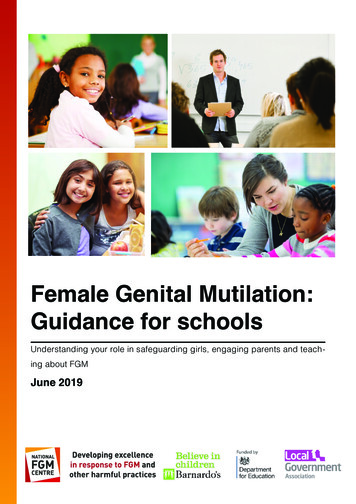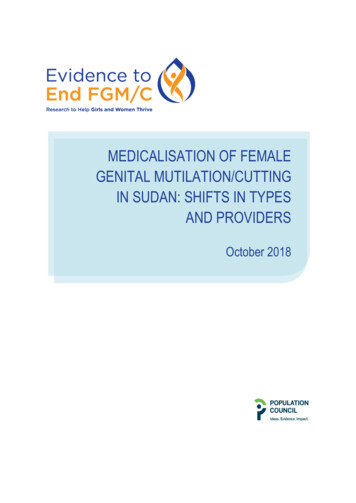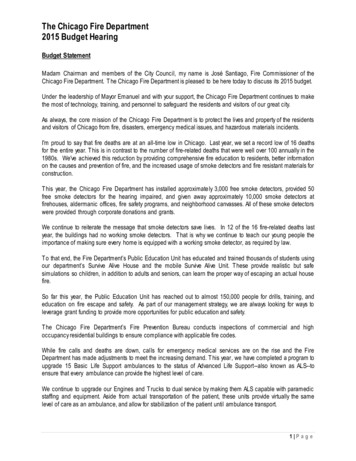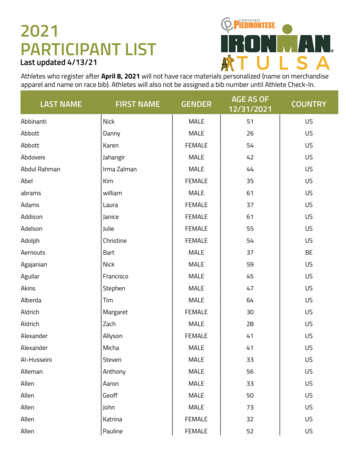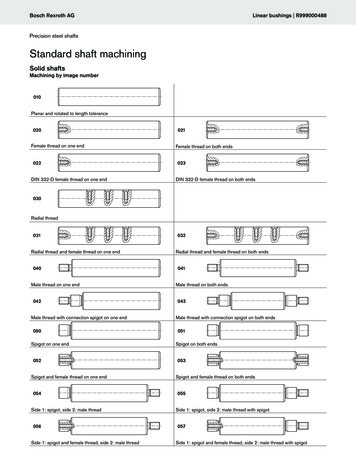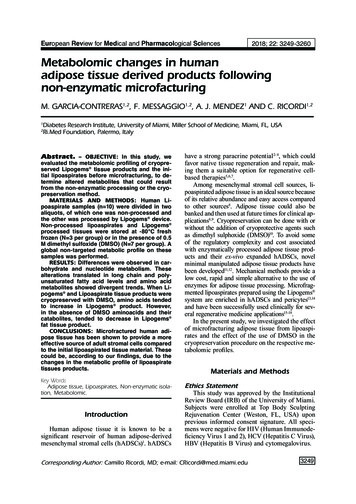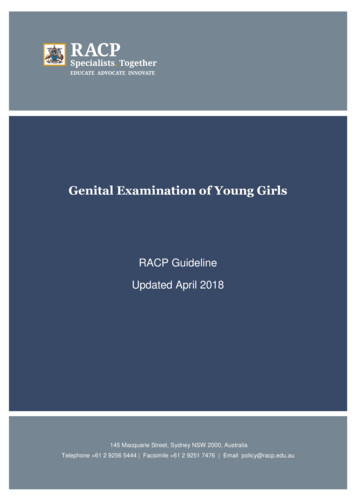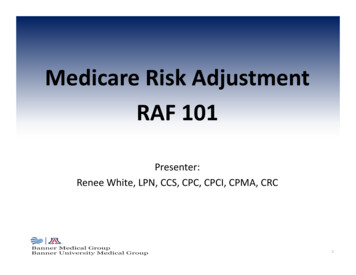
Transcription
HEALTH IMPACTS OFFEMALE GENITALMUTILATION/CUTTING:A SYNTHESIS OF THEEVIDENCEJULY 2016
HEALTH IMPACTS OF FGM/C:A SYNTHESIS OF THEEVIDENCEOCTOBER 2016SAMUEL KIMANIAFRICA COORDINATING CENTRE FOR THE ABANDONMENTOF FEMALE GENITAL MUTILATION /CUTTING (ACCAF)UNIVERSITY OF NAIROBIJACINTA MUTESHICAROLYNE NJUEPOPULATION COUNCILi
Evidence to End FGM/C: Research to Help Girls and Women Thrive generates evidence to inform andinfluence investments, policies, and programs for ending female genital mutilation/cutting in differentcontexts. Evidence to End FGM/C is led by the Population Council, Nairobi, in partnership with the AfricaCoordinating Centre for the Abandonment of Female Genital Mutilation/Cutting (ACCAF), Kenya; Genderand Reproductive Health & Rights Resource Center (GRACE), Sudan; Global Research and Advocacy Group(GRAG), Senegal; Population Council, Nigeria; Population Council, Egypt; Population Council, Ethiopia;MannionDaniels, Ltd. (MD); Population Reference Bureau (PRB); University of California, San Diego (Dr.Gerry Mackie); and University of Washington, Seattle (Prof. Bettina Shell-Duncan).The Population Council confronts critical health and development issues, fromstopping the spread of HIV to improving reproductive health and ensuring thatyoung people lead full and productive lives. Through biomedical, social science,and public health research in 50 countries, we work with our partners to deliversolutions that lead to more effective policies, programs, and technologies thatimprove lives around the world. Established in 1952 and headquartered inNew York, the Council is a nongovernmental, non-profit organization governedby an international board of trustees. www.popcouncil.orgACCAF is based at the University of Nairobi, College of Health Sciences, apremier institution for training of health care professionals, and a leader inhealth research and community services. Our goals and objectives are to:strengthen capacity for FGM/C research in Africa, implement FGM/Cinterventions, and improve care for women and girls who have undergoneFGM/C, monitor progress in the abandonment of FGM/C, and inform policyprogramming on FGM/C issues.Suggested citation: Kimani Samuel, Jacinta Muteshi and Carolyne Njue. October, 2016. Health Impacts ofFGM/C: A Synthesis of the Evidence,” Evidence to End FGM/C Programme: Research to Help Girls andWomen Thrive. New York: Population Council. http://www.popcouncil.org/EvidencetoEndFGM-CPlease address any inquiries about the Evidence to End FGM/C programme consortium to:Dr. Jacinta Muteshi, Project Director, jmuteshi@popcouncil.org 2016 The Population Council, Inc.Funded by:This document is an output from a project funded by UK aid by the UK Government for thebenefit of developing countries. However, the views expressed and information containedin it are not necessarily those of, or endorsed by, the UK Government, which can accept noresponsibility for such views or information or for any reliance placed on them.ii
AcknowledgmentsThis report was authored by Dr. Samuel Kimani, senior lecturer at the School of Nursing and aresearcher at the Africa Coordinating Centre for the Abandonment of Female GenitalMutilation/Cutting (ACCAF), University of Nairobi; and Jacinta Muteshi, Programme Director, andCarolyne Njue, Senior Technical Advisor, at Evidence to End FGM/C: Research to Help Girls andWomen Thrive, Population Council. The authors of this report are grateful for the insightful reviewand comments by Prof. Guyo Waqo Jaldesa and Prof. Joseph Karanja of the ACCAF team; andJohn Townsend, Charlotte Warren, Wilson Liambila, and Charity Ndwiga of the Population Council.Special thanks to other reviewers: Ian Askew, director, Department of Reproductive Health andResearch at the World Health Organization (formerly of the Population Council) and expertreviewers at DFID; R. Elise B. Johansen of the Norwegian Center for Violence and TraumaticStress Studies in Oslo, Norway; and Christina Catherine Pallitto and Lale Say, both of the WorldHealth Organization. The authors also appreciate the editorial support of Carol Gachiengo. 2016 The Population Council, Inc. All rights reserved.iii
TABLE OF CONTENTSAcknowledgments . iiiAcronyms . vEXECUTIVE SUMMARY . vi1.0 BACKGROUND . 11.1 Context .11.2 Rationale .12.0 APPROACH AND METHODS. 22.1 Objectives .22.2 Desk review .22.3 Data and analysis .33.0 REVIEW FINDINGS . 43.1 Synthesis of evidence: Health impacts .43.2 Synthesis of evidence: Curative and preventive interventions recommended for healthimpacts of FGM/C . 103.3 Improvements to enhance pre-service training for frontline health care providers . 14Conclusion . 17References . 18iv
ACRONYMSACCAFAfrica Coordinating Centre for the Abandonment of Female GenitalMutilation/CuttingDFIDDepartment for International DevelopmentFGM/CFemale genital mutilation/cuttingFIGOInternational Federation of Gynecology and ObstetricsGRACEGender and Reproductive Health & Rights Resource CenterGRAGGlobal Research and Advocacy GroupHIVHuman immunodeficiency virusHIV/AIDSHuman immunodeficiency virus/Acquired immune deficiency syndromeMDMannionDaniels, Ltd.MeSHMedical Subject Headings(NS)Not statistically significantPPHPostpartum haemorrhagePRBPopulation Reference Bureau(S)Statistically significantSTDsSexually transmitted diseasesWHOWorld Health Organizationv
EXECUTIVE SUMMARYFemale genital mutilation/cutting (FGM/C) continues to be a threat to women’s and girls’ healthand human rights globally. A sizeable body of evidence has developed over the past threedecades on the direct health impacts of FGM/C. However, the evidence has been spread out anddetached in diverse research, interventional, and training materials, making it cumbersome forquick reference when responding to women and girls exposed to the health effects of FGM/C.The Africa Coordinating Centre for the Abandonment of Female Genital Mutilation/Cutting(ACCAF), with support from the Population Council, sought to synthesize the evidence on thehealth impacts of FGM/C, identify recommended interventions, and compile and analyse theexisting reference materials.The goal of the review was to inform the development of a comprehensive set of trainingguidelines and materials for frontline health care providers so they can manage the care ofwomen and girls who have undergone FGM/C, prevent the practice at the community level, andaccelerate abandonment of FGM/C practices. An analysis of existing systematic reviews, metaanalyses, and published studies on health impacts associated with FGM/C and their specificinterventions was conducted. A content analysis of 44 reference materials related to FGM/C wasconducted using an updated data abstraction form that included 17 review criteria. Descriptivestatistics were applied to the generated data to understand the components of the analyseddocuments. A review and validation of the outcomes and interventions were carried out bymedical experts on the ACCAF team.The health impacts associated with FGM/C that require interventions have been broadlycategorised into: immediate, genito-urinary, gynecological, obstetric, sexual and psycho-socialconsequences. An analysis of existing training and research reference materials on FGM/Cmanagement showed major strength in epidemiology, but scored marginally on physical,gynecological, and obstetric complications. In addition, the reference materials scored poorly onthe sexual and psycho-social impacts of FGM/C. Curative and preventive interventionalapproaches are recommended in the review for the various health consequences. Specifically,capacity building for health care providers to respond to women exposed to FGM/C in both healthcare facility and community settings should be prioritized. In addition, strengthening the healthcare systems by anchoring FGM/C interventions to existing programs and socio-communitystructures, especially in high prevalence areas, and by establishing supervisory mechanisms,protocols, documentation, and referral systems where expert care is lacking, among otherinterventions, will greatly help the response to the needs of cut women and girls while preventingnew FGM/C cases.This analysis underscores the health impacts associated with FGM/C and compelling reasons fortheir interventions. Overall, the recommended interventions were informed by recommendedbest practices based on study reports, experts, and the strength of the available evidence.Women’s health is a human rights issue and women’s empowerment cannot be separated fromissues related to women’s health. Therefore, a comprehensive, user-friendly training guide isrequired. Moving forward, Evidence to End FGM/C: Research to Help Girls and Women Thriveplans to collaboratively review existing curricula and related materials for health professionalsbefore these much-needed training materials and guidelines for health care providers can bedrafted; and to conduct new research to deepen understanding on all the health impacts ofFGM/C and their interventions.vi
1.0 BACKGROUND1.1 ContextFemale genital mutilation/cutting (FGM/C) is a culturally entrenched global practice that not onlyis considered an evident human rights violation but also has resultant health and socialrepercussions on girls and women. It has been implicated in serious health consequences,significant morbidity, health burden, and poor health indicators [1, 2]. A sizeable body ofevidence has been developed over the past three decades on the direct health impacts ofFGM/C. Systematic reviews by the Norwegian Knowledge Centre for the Health Services providea useful summary of these impacts, organized into obstetric, gynecological, and immediatehealth consequences depending on the type of FGM/C [3]. There are four documented types ofFGM/C: clitoridectomy (type 1), the partial or total removal of the clitoris and prepuce; excision(type II), the partial or total removal of the clitoris and the labia minora; infibulations (type III), thenarrowing of the vaginal orifice through creation of a covering seal by cutting and placingtogether the inner and/or outer labia with or without the removal of the clitoris; and others (typeIV), including non-therapeutic harmful procedures to the female genitalia such as pricking,piercing, incising, scraping, and cauterization [2]. Researchers have alluded to the fact thatFGM/C has also been associated with social, sexual, psychological, and mental consequencesfor women and girls.To enable health practitioners to address the consequences associated with FGM/C, WHO,various ministries of health, organizations, and experts have presented information in the form oftraining and intervention materials. Currently, however, there is no single comprehensivereference material and practitioners are required to consult various materials when faced with anFGM/C challenge. This can be inefficient and wasteful in terms of time for both clients andproviders, and in some cases may result in serious complications or the loss of life. Therefore, acomprehensive package of interventions, skills support, and training materials on health impactsassociated with FGM/C would be most useful to health practitioners. Such materials wouldsupport the provision of appropriate, efficient, and effective gynecological, obstetric, medical,and related treatment services, including preventive strategies.This synthesis has been spearheaded by the ACCAF team, with support from the PopulationCouncil and in consultation with recognized professional experts in the field of FGM/C, includingWHO and FIGO.1.2 RationaleThis review synthesis describes the health consequences of FGM/C, identifies recommendedinterventions, and assesses existing interventional and training materials with an aim towardinforming a formal review of curricula and the development of user-friendly materials formitigating the health consequences of FGM/C. The review is composed of three components: thehealth impacts associated with FGM/C, the medical and socio-community interventionsrecommended for the consequences, and analyses of FGM/C reference materials for inculcatingknowledge, management skills, and prevention of the practice by health practitioners. Thecomponents of this review document are interrelated and are intended to synergize each otherseamlessly.1
2.0 APPROACH AND METHODS2.1 ObjectivesThe ultimate goals of this review are to support recommendations for the development ofappropriate, user-friendly training materials and resources for use in medical training colleges fortrainee health providers; and to inform the in-service and/or continuous medical education forhealth care providers already working in high-prevalence FGM/C areas, for appropriate correctiveas well as preventive interventions in the various settings.To achieve this goal, the following specific objectives were addressed:i.Review existing systematic reviews, meta-analyses, and published studies to identify thestrongest evidence concerning FGM/C-related health outcomes for which interventionscould be recommended.ii. Identify medical and socio-community interventions that have been recommended for thehealth consequences associated with FGM/C and its prevention.iii. Compile, review, and identify strengths and weaknesses of existing reference materialsand propose improvements that would enhance pre-service training for frontline healthcare providers and that could be adapted for in-service training courses.2.2 Desk reviewThe review of the literature was conducted using the terms “female genital mutilation,” “femalegenital cutting,” or “female circumcision” combined with medical subject heading (MeSH) terms“obstetrics,” “gynecologic,” psychologic,” and “women’s health” and keywords “health impacts,”“health effects,” “health outcomes,” “health consequences,” “interventions,” “training manual,”and “training guidelines.” Databases, including PubMed/MEDLINE, were searched applying thefollowing parameters: year of publication between 1985 and 2015; human; and in the Englishlanguage. The titles and abstracts of all articles identified through the literature search werescanned for relevance. Documents were selected for full review if they specifically mentionedFGM/C and reported data on health impacts, interventions, prevention, and training materialsrelated to FGM/C. Human observational studies were reviewed, including cross-sectional, casecontrol, prospective, and comparative studies; meta-analyses conducted on existing studies data;and cohort or population-based studies that used quantitative methodology. The respondentsincluded women, girls, and health professionals, such as obstetricians, gynecologists, nurses,midwives, and researchers. The review included health impacts associated with FGM/C,recommended prevention and interventions to mitigate the health effects, and materials thatshould be included in training as a requirement for health care providers to care for women andgirls affected by FGM/C and for prevention of the practice. Publications were excluded if theyused qualitative study designs because of the non-randomized nature of sampling techniquesand the pitfalls thereof; were not in English and could not be translated by default languagetranslation software; or were more than 30 years old.Quality measures for considering the systematic reviews and research reports included: sampledescription (details included women and girls with all types of FGM/C, nationality, and age ofrespondents); sampling method (description of site/setting and sampling procedure); credibility2
of researcher/author (professional midwife, nurse, obstetrician, gynecologist, surgeon, orresearcher); and whether or not the systematic reviews were reviewed by content experts.Additionally, the reviewed papers offered citation sources for health outcomes, theirinterventions, and prevention and training guidelines for health professionals. These citationswere subjected to PubMed/MEDLINE databases for retrieval and scrutinized to meet theaforementioned criteria. To supplement this process, other literature and training materials thatwere not available online were obtained from ACCAF, Population Council, and subject matterexperts. Data were extracted and then any inconsistencies were resolved by checking full-textversions of the documents, counterchecking against the latest literature, and discussing withfield experts.2.3 Data and analysisAfter reviewing relevant documents andidentifying the FGM/C health consequences,the reference materials were compiled andscored, and recommended interventions wereoutlined.Thecompilationinvolvedsystematically assessing the evidence withinthe existing reference materials andpublished studies. The components of FGM/Cin each individual piece of evidence wereassessed using a standard data abstractionform that included 17 review criteria (Box 1).The criteria were developed based on acombination of different categories asprovided in three guideline documents [4, 5,6] and formed the basis for analysing whatshould be included in comprehensive, userfriendly training materials.Each individual reference material wasassessed based on the presence of keycomponents of FGM/C (Box 1). Theirstrengths and weaknesses were furtherdetermined based on details and depth ofcontent material elaboration.Box 1: Seventeen review criteria developedfor assessing FGM/C reference materialsNo.1234567891011121314151617Criteria: Key components of FGM/CPresent Absent OBackground and description of FGM/CComplications of FGM/CFGM/C and human rightsFGM/C management during pregnancy, labor,delivery, and postpartum periodManagement of girls and women with gynecologicalcomplicationsManagement of girls and women with sexualcomplicationsManagement of girls and women withpsychological/mental complicationsCounselingMedicalizationProfessional ethics and legal implications of FGM/CCommunity involvement in prevention of FGM/CCommunity health education and advocacyFGM/C and family planningReferral procedureResearchTrainingMonitoring and evaluationA total of 44 reference materials were compiled, analysed, and categorised into three groups:interventional (73%; n 32), training materials (11%; n 5), and research reports (16%; n 7),respectively. The analyses of the materials involved ascertaining whether or not they capturedthe specific FGM/C components in the 17 review criteria. The analyses of the materials basedon the criteria outlined in Box 1 yielded the following key insights as presented in Tables 1 and2.3
Table 1. Percentage score of reference material based on 17 review criteriaPercentage category (%)75 and above50-7425-490-24HighestLowestScore out of 17Frequency n (%)13-179-124-80-315 (88%)1 (6%)5 (10)6 (13)16 (33)21(44)3 (7)5 (11)Table 2. The overall scores on specific FGM/C components for the reviewed reference materialsS/No1234567891011121314151617Components of FGM/CBackground and description of FGM/CComplications of FGM/CFGM/C and human rightsFGM/C management during pregnancy, labour, delivery, and postpartumperiodManagement of girls and women with gynecological complicationsManagement of girls and women with sexual complicationsManagement of girls and women with psychological/mental complicationsCounselingMedicalisationProfessional ethics and legal implications of FGM/CCommunity involvement in prevention of FGM/CCommunity health education and advocacyFGM/C and family planningReferral procedureResearchTrainingMonitoring and evaluationScores, n (%)42 (96)41 (93)29 (66)26 (59)24 (55)19 (43)18 (41)22 (50)26 (59)32 (73)25 (57)25 (57)11 (25)16 (36)23 (52)14 (32)11(25)Of the 44 reference materials analysed using the 17 review criteria for FGM/C components, thehighest score was 15 (6.8%, n 3) while the lowest was 1 (11.4%, n 5) (Table 1). Only 10.4%(n 5) scored 75% and above, while 12.5% (n 6) scored 50 to 74% on the 17-point criteria. Morethan 75% (n 20) of the analysed reference materials contained less than 50% of the key FGM/Ccomponents. The highest (88.2%) score was 15, achieved by 6.8% (n 3), while the lowest (5.9%)score was 1, attained by 11.4% (n 5) of the reference materials, respectively. Only 25% (n 11)of the reference materials met 50% and above of the criteria. On the other hand, 40.9% (n 18)of the materials scored below 25% of the criteria.3.0 REVIEW FINDINGS3.1 Synthesis of evidence: Health impactsThis section outlines the health impacts attributable to FGM/C as collected from the systematicreviews, meta-analyses, and published studies conducted in the past three decades. The reviewidentified 5 categories of health impacts attributable to FGM/C: immediate, genito-urinary,obstetric, sexual, and psycho-social complications. The health impacts described in the sectionsbelow, based on available scientific evidence on FGM/C accumulated over the last three4
decades, warrant interventions by health care providers in health facilities as well as incommunity settings.3.1.1 Immediate (acute) complicationsThe cutting of women’s and girls’ clitoris and labia is usually done with crude unsterileinstruments and without anesthesia, by traditional practitioners who have little knowledge offemale anatomy [7]. The cutting results in immediate harm. Bleeding (haemorrhage) occurs dueto laceration or severing of branches of the pudendal or clitoral arteries, which have high bloodpressure, causing a strong flow of blood during and shortly after the cutting process. Otherimmediate complications include shock, genital tissue swelling, fever, infections, problems withurination (acute urinary retention, hesitancy), and delayed wound healing, as corroborated byobservational studies involving large samples of women and girls of various ages who hadundergone various types of FGM/C [3] and by study reports [8, 9]. Evidence also shows that girlssuffer more than one immediate complication, and in some cases deaths have been attributeddirectly to FGM/C [10-14]. Death can result from severe bleeding, pain and trauma, severe andoverwhelming infection, or a combination of these complications. The immediate harms vary withthe type of FGM/C, with the greatest risk seen among type III, relative to types I and II [15] (Table3).The evidence on the magnitude of immediate complications associated with FGM/C variedacross the reviewed studies. This variation may have been due to under-reporting of thecomplications or to the timing of post-procedure observations. Some studies have reported veryhigh rates of girls who have undergone FGM/C but experienced no bleeding [15, 16]. Suchdisparities may be the result of methodological differences in data collection, with clinicalassessment likely to be more objective and accurate, while self-reporting may result in grossunder-reporting. This reasoning is supported by the fact that many women underwent FGM/C asinfants or children and they may not remember any immediate adverse effects. Furthermore,women may not link complications arising during childbirth or later in life to the genital cuttingthey underwent as children. Additionally, FGM/C-related complications may be considered asnormal and natural to women, especially among populations where FGM/C is nearly universal,due to social norms [17].5
Table 3. Immediate (acute) outcomes attributed to gDeathReasonsLaceration to pudendal and/or clitoralarteries, which have high flow andpressureInjuries to cut tissues and nerves, swellingand pressure, no anesthesiaBlood loss (haemorrhagic shock), severepain and trauma (neurogenic shock), whichcan be fatalTrauma and injured tissues of urethra,vagina, perineum, and rectumInflammation, trauma, infectionUnsterile procedure, skin destruction (e.g.,tetanus, hepatitis, HIV)Swelling, inflammation around the wound,fear of pain of passing urine on the rawwound, or injury to the urethraFailure of wound to heal due to infection,irritation from urine or rubbing whenwalking, or an underlying condition, suchas anemia or malnutritionSevere bleeding, pain, and trauma, orsevere and overwhelming infection, or acombination of the aboveNumber size (n)133,515(S)/(NS)1ReferencesSBerg et al.2014;Almroth et al.2005El Dareer1983; Trew2013; Migiro2014; Asuen1977; Badejo1983; Osifo &Evbuomwan20093.1.2 Late (chronic) genito-urinary problemsFemale genital cutting is associated with chronic problems affecting the genital and/or urinarysystems of women and girls. This has been corroborated by several comparative studies involvinglarge numbers of women and girls [3, 18, 19]. The specific genito-urinary problems commonlyreported include: genital tissue damage, vaginal discharge, itching, urological complications, andinfections [3]. In light of this evidence, interventions for these complications should bedeveloped. Other genito-urinary outcomes such as scarring, keloids, abscesses, fistulae,damaged tissue (perineum, anal sphincter), disfigurement, vaginal obstruction, and cysts arerarely encountered in the research reports, possibly because of lack of rigorous research anddocumentation [3]. This may be due to methodological differences in data collection and the factthat most studies do not disaggregate chronic genital urinary problems data against the type ofcutting, which may affect the interpretation of the data [3] (Table 4). Additionally, someoutcomes, such as HIV, STDs, and infertility, are rarely encountered in the literature and notreported.1S significant; NS not significant6
Table 4. Late (chronic) genito-urinary outcomes attributed to FGM/COutcomeRationale for theoutcomeStudy typeStudiesSamplesize (n)(S) tional43,657SNwanjei & Otiono 2003;Okonofu et al. 2002; Elnashar& Abdelhady 2007VaginalitchingInfections, trauma,reaction due todischargeCrosssectional43,657SMorrone et al. 2002; Okonofuet al. 2002; Elnashar &Abdelhady 2007PainfulurinationDamage to theurethral opening orscarring of themeatusComparative63,611SMorison et al. 2001; Okonofuet al. 2002; Elnashar &Abdelhady 2007; De Silva1989Menstrualproblems3Due to partial or totalocclusion of thevaginal openingCrosssectional56,564SINSEED 2005; El Defrawi et al.2001; Morrone et al. 2002;Nwajei & Al Otieono 2003Chronicgenito-urinaryinfectionsAscending urinarytract infectionsComparative1028,940SINSEED 2005; El Defrawi et al.2001; Fillo & Leone 2007ReproductivetractinfectionsOcclusion of thevagina and urethracausing stasis andclimbing of theinfections22,412GenitalinfectionsTrauma, entry ofCrossinfectious organisms, sectionalinflammation due todischargeProspective22,412SJones et al. 1999; Brewer et al.2007Urinary tractInfectionsOcclusion of theurethraMeta-analyses 59,414SINSEED 2005; El Defrawi et al.2001; Browning et al. 2010;Fillo & Leone 2007Meta-analyses 59,414SNwajei & Otiono 2003BacterialvaginosisGenital tissuedamageHIVSTDsInfertilityTrauma, entry ofinfectious organisms,reaction due todischargeTrauma due toFGM/C, inflammationdue to discharge,infectionsSmall vaginalopening, cuts andtears, sharing ofcutting instrumentsTrauma, entry ofinfectious organisms,inflammation due todischarge, poorhygiene due to painPelvic infections,damage toreproductive organs,painful intercourseCrosssectionalSJones et al. 1999; Brewer et ectionalMorison et al. 2001; Nwajei &Otiono 2003; Okonofu et al.2002; Elnashar & Abdelhady2007Klouman et al. 2005;Maslovskaya et al. 2009;Yount & Abraham 2007; Balk2000Nwajei & Otiono 2003;Klouman et al. 2007;Maslovskaya et al. 2009;Yount & Abraham 2007; Balk2000El Defrawi et al. 2001;Browning et al. 2010; Nwajei &Al Otiono 2003; Yount &Abraham 2007; Inhorn & Buss1993; Jackson et al. 2005;Larsen & Okonofua 2002; Berg& Underland 2013* The higher number represents case-control studies while the lower number represents cross-sectional studies.23S significant; NS not significant.Dysmenorrhea, difficulty in menstruation, irregular menses, and d
FIGO International Federation of Gynecology and Obstetrics GRACE Gender and Reproductive Health & Rights Resource Center . plans to collaboratively review existing curricula and related materials for health professionals . health consequences depending on the type of FGM/C [3]. There are four documented types of FGM/C: clitoridectomy (type .
